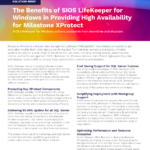SIOS LifeKeeper HA for Milestone XProtect
SIOS LifeKeeper for XProtect is a Milestone Verified Solution, offering compatibility with all versions of SQL Server, support for Workgroup environments, protection of key Milestone components, and flexibility in deployment. SIOS LifeKeeper empowers organizations to ensure uninterrupted operations, data integrity, and seamless access to their surveillance systems.

Download now
Reproduced with permission from SIOS

